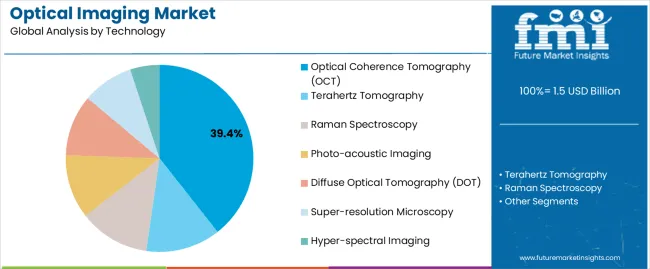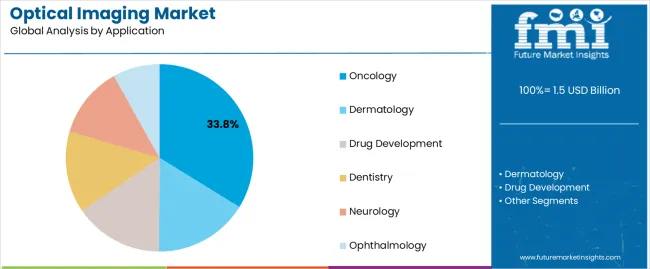The Optical Imaging Market is estimated to be valued at USD 1.5 billion in 2025 and is projected to reach USD 2.4 billion by 2035, registering a compound annual growth rate (CAGR) of 4.5% over the forecast period.
The optical imaging market is experiencing accelerated growth driven by advancements in imaging technologies, rising prevalence of chronic diseases, and increasing adoption of non-invasive diagnostic procedures. The current market landscape is defined by expanding clinical applications, higher accuracy of imaging systems, and integration of optical technologies with digital platforms to enhance visualization and data interpretation.
Growing investment in research and development, coupled with regulatory support for innovative diagnostic solutions, is strengthening market stability. Demand is also being reinforced by the rising need for early disease detection and precision diagnostics across healthcare systems.
The future outlook remains positive as technological evolution continues to improve image resolution, data processing speed, and patient comfort The growth rationale is further supported by expanding healthcare infrastructure, the miniaturization of imaging devices, and growing clinical acceptance of optical techniques as safe and efficient alternatives to traditional imaging modalities, positioning the market for sustained expansion globally.

| Metric | Value |
|---|---|
| Optical Imaging Market Estimated Value in (2025 E) | USD 1.5 billion |
| Optical Imaging Market Forecast Value in (2035 F) | USD 2.4 billion |
| Forecast CAGR (2025 to 2035) | 4.5% |
The market is segmented by Technology and Application and region. By Technology, the market is divided into Optical Coherence Tomography (OCT), Terahertz Tomography, Raman Spectroscopy, Photo-acoustic Imaging, Diffuse Optical Tomography (DOT), Super-resolution Microscopy, and Hyper-spectral Imaging. In terms of Application, the market is classified into Oncology, Dermatology, Drug Development, Dentistry, Neurology, and Ophthalmology. Regionally, the market is classified into North America, Latin America, Western Europe, Eastern Europe, Balkan & Baltic Countries, Russia & Belarus, Central Asia, East Asia, South Asia & Pacific, and the Middle East & Africa.

The optical coherence tomography (OCT) segment, accounting for 39.40% of the technology category, has emerged as the leading technology due to its superior imaging resolution and real-time visualization capabilities. Its dominance is driven by widespread adoption in ophthalmology, cardiology, and oncology for high-precision tissue analysis.
The technology’s ability to deliver cross-sectional imaging without ionizing radiation has strengthened its preference among clinicians and researchers. Continuous improvements in system design, including portable and high-speed OCT devices, have enhanced diagnostic accessibility and workflow efficiency.
Strategic collaborations between device manufacturers and healthcare institutions are expanding the clinical utility of OCT systems, while ongoing innovation in spectral and swept-source technologies is further elevating performance standards These advancements are expected to sustain the segment’s market share and reinforce its position as the cornerstone technology within the optical imaging landscape.

The oncology segment, representing 33.80% of the application category, has maintained its leading position owing to the increasing utilization of optical imaging for early cancer detection, tumor margin assessment, and treatment monitoring. The segment’s growth is driven by the high diagnostic accuracy and non-invasive nature of optical imaging techniques that facilitate real-time visualization of cellular and tissue structures.
Expanding research on optical biomarkers and fluorescence-based imaging has strengthened clinical adoption. Hospital and diagnostic centers are increasingly integrating optical imaging systems into oncology workflows to enhance diagnostic precision and reduce procedural risks.
The growing burden of cancer worldwide and rising investments in cancer research infrastructure are further supporting demand Continuous technological advancements and regulatory approvals for optical diagnostic systems are expected to reinforce this segment’s leadership and sustain its growth trajectory throughout the forecast period.
| Leading Technology | Optical Cohorence Tomography |
|---|---|
| Value Share (2025) | 54.0% |
By technology, the optical coherence tomography (OCT) segment is projected to acquire a greater share of 54.0% in the optical imaging industry. Key reasons that support the take-up of optical coherence tomography are as follows:
| Leading End Users | Hospitals |
|---|---|
| Value Share (2025) | 38.0% |
Hospitals form the prominent end users of optical imaging technology. The latest market survey conducted by FMI analysts concluded that hospitals make up 38% of the overall market. Following factors explain the dynamics behind the increasing use of optical imaging solutions by hospitals:
The Asia Pacific market for optical imaging is growing at a relatively higher pace than its developed counterparts. This can be attributed to the increasing investments in the healthcare sector to improve the infrastructure. Growing knowledge about optical imaging is also creating opportunities for manufacturers to profit from the current market scenario.
In North America, key players are leveraging the opportunities offered to them, as the region is well-equipped with technological advancements. Companies are also taking significant steps to bring innovation to the global optical imaging industry.
| Countries | Forecast CAGR (2025 to 2035) |
|---|---|
| The United States | 3.80% |
| Spain | 4.60% |
| India | 5.90% |
| Thailand | 5.70% |
| Malaysia | 5.10% |
The optical imaging industry in the United States is rising at a CAGR of 3.8% through 2035. The market is backed by following factors:
Adoption of optical imaging equipment is expanding in Spain at a CAGR of 4.60% from 2025 to 2035. The market is supported by the given factors:
The India optical imaging industry is expected to record at a CAGR of 5.90% through 2035. Key factors that are pushing the market growth are:
The optical imaging industry in Thailand is expanding at a 5.70% CAGR over the forecast period. Top factors that are propelling the sales of optical imaging equipment are as follows:
Adoption of optical imaging technology in Malaysia is increasing at a 5.1% CAGR through 2035. Factors that are promoting the sales in the market are:

Key players are focusing on bringing innovations in their product offerings. Additionally, they are concentrating on making a sustainable impact in the optical imaging industry. Market participants are engaging in multiple strategies to work their way to the top when it comes to investments and developments.
Market players are trying to capture emerging markets with an expanding healthcare sector and rising appetite for advanced medical technologies. Industry contenders are tailoring their products and marketing strategies to serve the specific requirements of cardiologists, ophthalmologists, or other specialists. Thus, offering solutions that help resolve the distinct market challenges.
Players are collaborating with universities and research institutions to foster innovation of new applications. Industry participants are further coming into strategic partnerships with healthcare providers and distributors to reach a wider population for the adoption of products. Key providers are also engaging in mergers and acquisitions to gain a greater market share.
Latest Developments in the Optical Imaging Industry
The global optical imaging market is estimated to be valued at USD 1.5 billion in 2025.
The market size for the optical imaging market is projected to reach USD 2.4 billion by 2035.
The optical imaging market is expected to grow at a 4.5% CAGR between 2025 and 2035.
The key product types in optical imaging market are optical coherence tomography (oct), terahertz tomography, raman spectroscopy, photo-acoustic imaging, diffuse optical tomography (dot), super-resolution microscopy and hyper-spectral imaging.
In terms of application, oncology segment to command 33.8% share in the optical imaging market in 2025.






Full Research Suite comprises of:
Market outlook & trends analysis
Interviews & case studies
Strategic recommendations
Vendor profiles & capabilities analysis
5-year forecasts
8 regions and 60+ country-level data splits
Market segment data splits
12 months of continuous data updates
DELIVERED AS:
PDF EXCEL ONLINE
Optical Spectrum Analyzer Market Size and Share Forecast Outlook 2025 to 2035
Optical Extinction Analyzer Market Size and Share Forecast Outlook 2025 to 2035
Optical Character Recognition Market Forecast and Outlook 2025 to 2035
Optical Satellite Market Size and Share Forecast Outlook 2025 to 2035
Optical Whitening Agents Market Size and Share Forecast Outlook 2025 to 2035
Optical Fingerprint Collector Market Size and Share Forecast Outlook 2025 to 2035
Optical Lens Materials Market Size and Share Forecast Outlook 2025 to 2035
Optical Microscope Market Size and Share Forecast Outlook 2025 to 2035
Optical Component Tester Market Size and Share Forecast Outlook 2025 to 2035
Optical EMI Shielding Adapters Market Size and Share Forecast Outlook 2025 to 2035
Optical Connector Polishing Films Market Size and Share Forecast Outlook 2025 to 2035
Optical Transmitter Market Size and Share Forecast Outlook 2025 to 2035
Optical Telephoto Lens Market Size and Share Forecast Outlook 2025 to 2035
Optical Lattice Clock Market Size and Share Forecast Outlook 2025 to 2035
Optical Grade Lithium Tantalate Wafers Market Size and Share Forecast Outlook 2025 to 2035
Optical Grade LiTaO3 Crystal Substrate Market Size and Share Forecast Outlook 2025 to 2035
Optical Brighteners Market Size and Share Forecast Outlook 2025 to 2035
Optical Liquid Level Sensor Market Size and Share Forecast Outlook 2025 to 2035
Optical Fiber Market Size and Share Forecast Outlook 2025 to 2035
Optical Communication and Networking Market Size and Share Forecast Outlook 2025 to 2035

Thank you!
You will receive an email from our Business Development Manager. Please be sure to check your SPAM/JUNK folder too.
Chat With
MaRIA